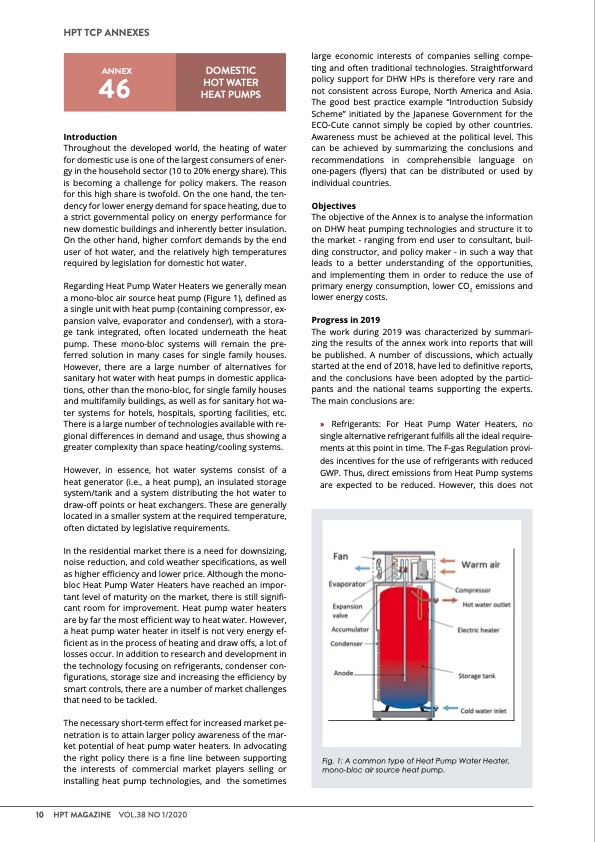
PDF Publication Title:
Text from PDF Page: 010
HPT TCP ANNEXES ANNEX 46 DOMESTIC HOT WATER HEAT PUMPS Introduction Throughout the developed world, the heating of water for domestic use is one of the largest consumers of ener- gy in the household sector (10 to 20% energy share). This is becoming a challenge for policy makers. The reason for this high share is twofold. On the one hand, the ten- dency for lower energy demand for space heating, due to a strict governmental policy on energy performance for new domestic buildings and inherently better insulation. On the other hand, higher comfort demands by the end user of hot water, and the relatively high temperatures required by legislation for domestic hot water. Regarding Heat Pump Water Heaters we generally mean a mono-bloc air source heat pump (Figure 1), defined as a single unit with heat pump (containing compressor, ex- pansion valve, evaporator and condenser), with a stora- ge tank integrated, often located underneath the heat pump. These mono-bloc systems will remain the pre- ferred solution in many cases for single family houses. However, there are a large number of alternatives for sanitary hot water with heat pumps in domestic applica- tions, other than the mono-bloc, for single family houses and multifamily buildings, as well as for sanitary hot wa- ter systems for hotels, hospitals, sporting facilities, etc. There is a large number of technologies available with re- gional differences in demand and usage, thus showing a greater complexity than space heating/cooling systems. However, in essence, hot water systems consist of a heat generator (i.e., a heat pump), an insulated storage system/tank and a system distributing the hot water to draw-off points or heat exchangers. These are generally located in a smaller system at the required temperature, often dictated by legislative requirements. In the residential market there is a need for downsizing, noise reduction, and cold weather specifications, as well as higher efficiency and lower price. Although the mono- bloc Heat Pump Water Heaters have reached an impor- tant level of maturity on the market, there is still signifi- cant room for improvement. Heat pump water heaters are by far the most efficient way to heat water. However, a heat pump water heater in itself is not very energy ef- ficient as in the process of heating and draw offs, a lot of losses occur. In addition to research and development in the technology focusing on refrigerants, condenser con- figurations, storage size and increasing the efficiency by smart controls, there are a number of market challenges that need to be tackled. The necessary short-term effect for increased market pe- netration is to attain larger policy awareness of the mar- ket potential of heat pump water heaters. In advocating the right policy there is a fine line between supporting the interests of commercial market players selling or installing heat pump technologies, and the sometimes large economic interests of companies selling compe- ting and often traditional technologies. Straightforward policy support for DHW HPs is therefore very rare and not consistent across Europe, North America and Asia. The good best practice example “Introduction Subsidy Scheme” initiated by the Japanese Government for the ECO-Cute cannot simply be copied by other countries. Awareness must be achieved at the political level. This can be achieved by summarizing the conclusions and recommendations in comprehensible language on one-pagers (flyers) that can be distributed or used by individual countries. Objectives The objective of the Annex is to analyse the information on DHW heat pumping technologies and structure it to the market - ranging from end user to consultant, buil- ding constructor, and policy maker - in such a way that leads to a better understanding of the opportunities, and implementing them in order to reduce the use of primary energy consumption, lower CO2 emissions and lower energy costs. Progress in 2019 The work during 2019 was characterized by summari- zing the results of the annex work into reports that will be published. A number of discussions, which actually started at the end of 2018, have led to definitive reports, and the conclusions have been adopted by the partici- pants and the national teams supporting the experts. The main conclusions are: » Refrigerants: For Heat Pump Water Heaters, no single alternative refrigerant fulfills all the ideal require- ments at this point in time. The F-gas Regulation provi- des incentives for the use of refrigerants with reduced GWP. Thus, direct emissions from Heat Pump systems are expected to be reduced. However, this does not Fig. 1: A common type of Heat Pump Water Heater, mono-bloc air source heat pump. 10 HPT MAGAZINE VOL.38 NO 1/2020PDF Image | Integration of Heat Pumps into the Future Energy

PDF Search Title:
Integration of Heat Pumps into the Future EnergyOriginal File Name Searched:
HPT-Magazine_no1_2020.pdfDIY PDF Search: Google It | Yahoo | Bing
CO2 Organic Rankine Cycle Experimenter Platform The supercritical CO2 phase change system is both a heat pump and organic rankine cycle which can be used for those purposes and as a supercritical extractor for advanced subcritical and supercritical extraction technology. Uses include producing nanoparticles, precious metal CO2 extraction, lithium battery recycling, and other applications... More Info
Heat Pumps CO2 ORC Heat Pump System Platform More Info
| CONTACT TEL: 608-238-6001 Email: greg@infinityturbine.com | RSS | AMP |